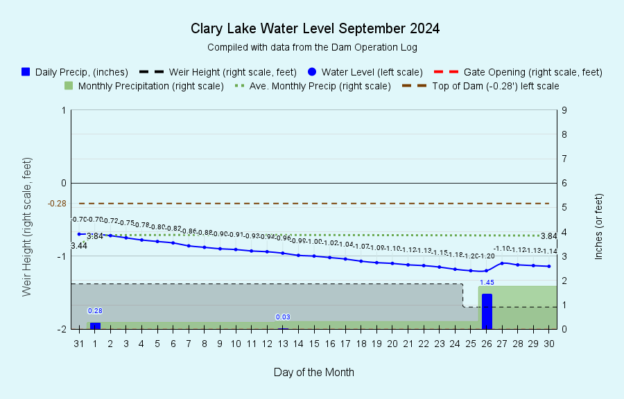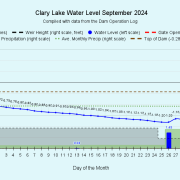I have archived the September 2024 water level chart (above, and at left). September is often when fall rains start to pick up but that didn’t happen this year. September was dry. Normal rainfall for the month is 3.84 inches but this year we received less than half that amount, just 1.75 inches with most of it coming in one storm on the 26th. Still, despite drought conditions in September, for the year with 42.32 inches, we’re still well above normal rainfall for this date. Prior to the rain storm late last week, the US Drought Monitor showed our area to be “Abnormally dry” and I don’t think the rainfall fully alleviated that condition. Still, there’s a good deal of ground water thanks to all the excess rainfall we’ve received this season.
The Clary Lake dam’s gate has been fully closed since the end of June which has helped maintain the lake level this summer, but the lack of September rain combined with some leakage and evaporation resulted in a net loss for the month of September of 0.44 feet of water with evaporation accounting for roughly 1/2 of that loss, which is to be expected. At the end of the month the lake level was down -1.14 feet. We’ve already pulled 3 stop logs but this didn’t affect the lake level because they weren’t holding back any water. We’re targeting a lake level of at least -1.5 feet or a possibly even a little lower by November 1st to accommodate some permitted shoreline work being done over on Duncan Road.
 Our outstanding water clarity of this summer only decreased a little bit during the month of September, dropping from a high of 5.45 m (17.88 feet) on August 11th to 4.53 m (14.86 feet) on September 8th then to 4.30 m (14.10 feet) on September 22nd which is still quite clear for this time of year. This decline in transparency is also to be expected: when the lake starts to cool off and turn over in September, Phosphorus rich water from the bottom of the lake starts to mix with the upper water layers where where sunlight reaches, spurring some algae growth. These early blooms are usually short-lived and not very intense due to getting a late start combined with cooling water temperatures and shorter days, and Indeed, that is what we saw around the 15th (picture at left). These short “ephemeral” blooms often go unnoticed because lake activity has dropped off with and people back to work and kids back in School. The bloom pictured was not lake-wide and only lasted a couple of days. Kelsie French and I will be going out for our final water quality monitoring session of 2024 next weekend.
Our outstanding water clarity of this summer only decreased a little bit during the month of September, dropping from a high of 5.45 m (17.88 feet) on August 11th to 4.53 m (14.86 feet) on September 8th then to 4.30 m (14.10 feet) on September 22nd which is still quite clear for this time of year. This decline in transparency is also to be expected: when the lake starts to cool off and turn over in September, Phosphorus rich water from the bottom of the lake starts to mix with the upper water layers where where sunlight reaches, spurring some algae growth. These early blooms are usually short-lived and not very intense due to getting a late start combined with cooling water temperatures and shorter days, and Indeed, that is what we saw around the 15th (picture at left). These short “ephemeral” blooms often go unnoticed because lake activity has dropped off with and people back to work and kids back in School. The bloom pictured was not lake-wide and only lasted a couple of days. Kelsie French and I will be going out for our final water quality monitoring session of 2024 next weekend.


